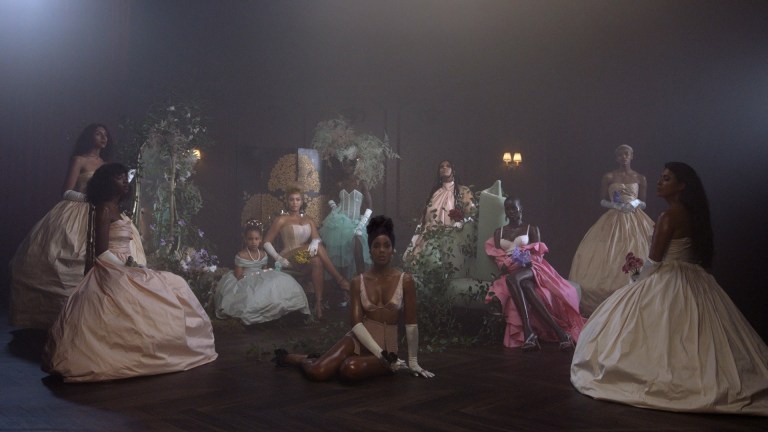Black is King Review
Beyoncé's visual album is an exquisite celebration of Black skin, Black bodies, and Black culture, in all its many facets.

Black is King is the visual album for the soundtrack The Lion King: The Gift, based on the 2019 live action Lion King, adapted from the 1994 animated film of the same name. It takes the story of the Lion King and reconceptualizes it around a Black boy, Simba in human form. Like the album, the film includes audio clips from the 2019 live-action film in interstitials between songs and sometimes disparate visuals. The clips also serve to connect the interspersed Simba narrative within the larger performance piece.
More than just a story about one young man reclaiming his identity and his throne, Black is King is a story about all of us, children of the African diaspora, finding our way back to our roots. It’s a visual metaphor for connecting to our heritage, deepening our understanding of what it means to be Black, and reaffirming our sense of self in this broader context. It is a celebration of Black skin, Black bodies, Black culture, in all its many facets, and it is a reminder that there is honor, and grace, in being Black.
The aesthetic encompasses the in-between of being authentic to the continent and representing the full breadth of what it means to be of Africa, and being authentic to the experience of being of Africa, but not from it. It is distinctly African-American—emphasis on the hyphen—the continent viewed through the eyes of someone who has only ever heard stories of home and who is only just rediscovering it for themselves.
The cinematography is affecting, shifting between large sweeping views of landscape and the natural beauty of the setting, to tighter shots that explore the depths and planes of faces. The camera is as interested in depicting the beauty of the space as it is in depicting the beauty of its inhabitants.The set dressing and costuming accentuate this, with bright greens set against the warm, beige backdrop of sandy plains or vibrant violets juxtaposed against the lush green of the bush. Stylist Zerina Akers brings a nuance to the costuming, finding a perfect balance between natural, earthy tones and materials, and the more arrestive and lavish designs.
In “FIND YOUR WAY BACK,” Beyoncé and performers are clad in Swarovski crystals, and set against a dark backdrop. The cinematography and styling work together to present the illusion of stars in a night sky, which echoes the sentiment of the preceding interstitial “Stars.” Fabric flows in “WATER” giving scenes an ethereal quality. Graphic black and white backgrounds and dancers in primary colors give “MY POWER” striking, powerful imagery, which is further accentuated by the performers’ movements and the way Blue Ivy commands the room. The fashion, the hair, and the movement is iconic.
“Mood 4 Eva” is perhaps the most straightforward display of music video materialism, with animal prints and gold jewelry, and a specific eye toward the excess and the opulence so rarely put on display in western media depicting African peoples. Young Simba is a prince in his castle, and Beyoncé and Jay Z are indulging in the wealth they built for themselves and the generations to follow.
Black is King is art, and it is imperfect. The language is directed toward boys and men explicitly. Not necessary excluding women, but the title says it all: Black is King. Not Regal, Royal or any ungendered terms that have the same meaning. The visual is very celebratory of feminine beauty and strength, but the words are not for those women. This is true of the album as well, which is centered around the narrative of a male character, but the dialogue interspersed throughout and the choice of poems are all very centered on the masculine. The one clear exception happens after ‘Keys To The Kingdom.’
This would not be a problem if it wasn’t an unintentional recreation of the dynamics we see in movements for Black liberation that center Black male victims of state violence, when Black women and trans folks are equally if not more vulnerable to the same injustice. We’re still asking for justice for Breonna Taylor, whose case went mostly ignored until protests for George Floyd renewed focus on other victims of state violence. Beyonce dedicates Black is King to her son, Sir, and in doing so makes a very clear point to uplift him. But when Black women and gender nonconforming individuals are also facing the same oppression, they deserve to be uplifted as well.
To my earlier point about the African aesthetic, Beyonce does not incorporate many distinct ethno-cultural elements. This is a valid criticism people have, though I see the lack of specificity as a feature. Black is King does not try to be culturally accurate to any of a number of specific African tribes or groups but makes an active attempt to amalgamate various cultural elements into a single Black (not African, not Af-Am, etc) aesthetic identity. In that, it succeeds. Black is King is a lush visual experience that feels too large for my 50-inch screen. It is worthwhile, it is affirming, it is rich. It is exquisite.